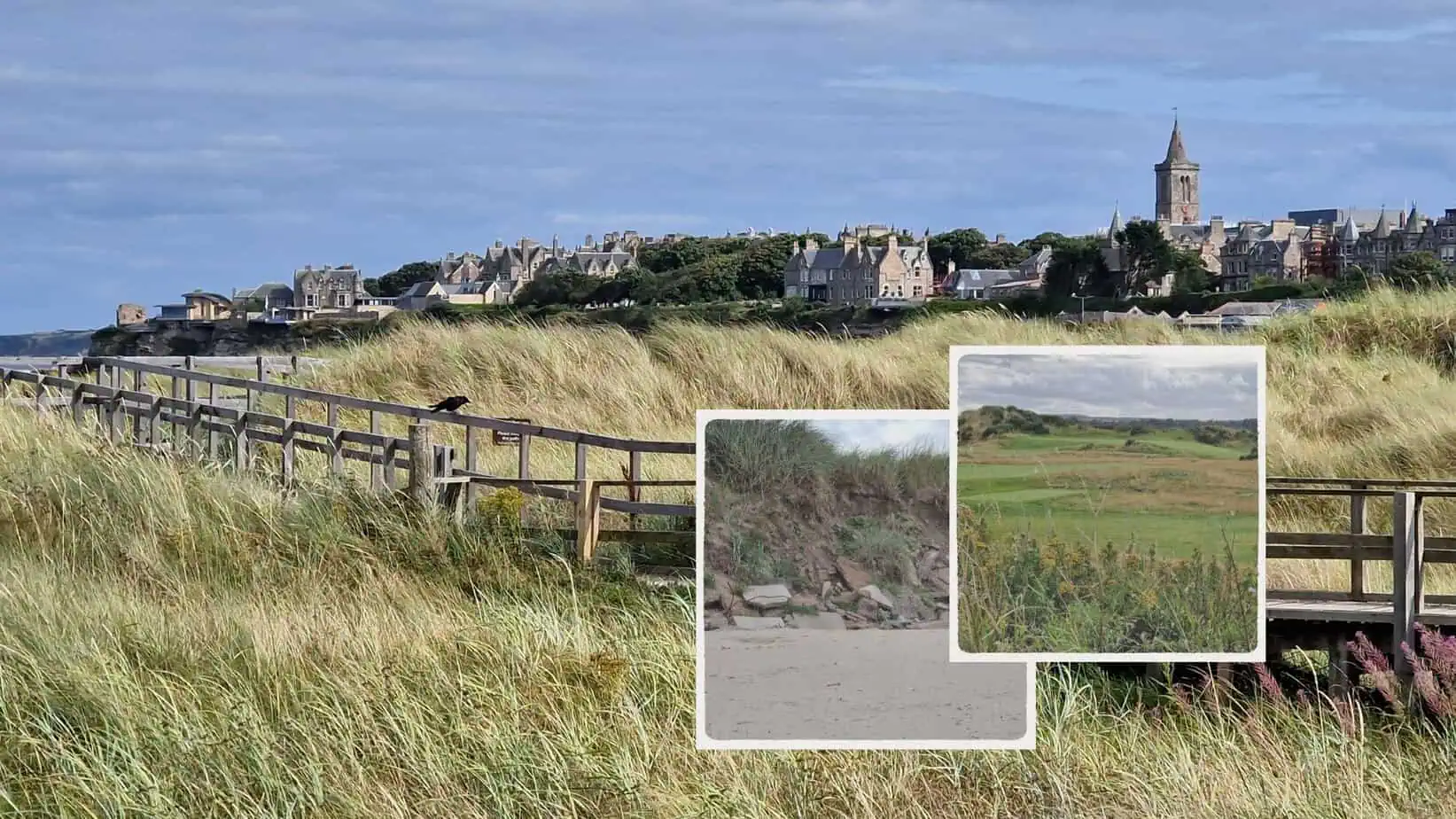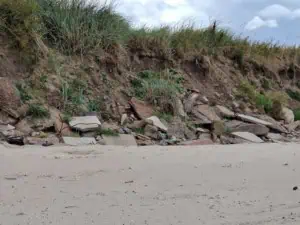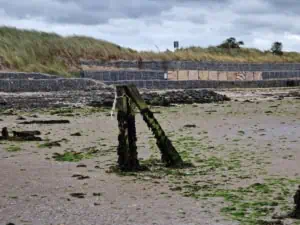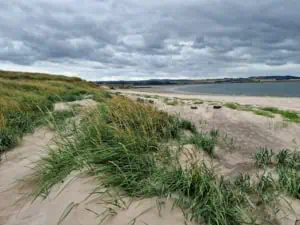From St. Andrews to Sylt: You can’t fight nature
No golf course is built to last forever. Especially not if it is located on the coast. An experience that more and more golf courses are making. Coastal erosion is an issue that affects areas of land in the USA and Germany just as much as in the Netherlands or England. For golf courses this means that holes have to be relocated and reinforcement options developed.
From St. Andrews to Dornoch
When Ranald Strachan talks about “our first line of defence”, he means the chain of dunes on the West Sands beach at St. Andrews. Behind it is a short stretch of grassland where a few sheep graze, but then comes the Jubilee Course. Anyone who asks Strachan whether it will still be there in 100 years’ time in view of climate change and rising sea levels will hear. “You never know, it could be that the first dune line falls, in which case the Jubilee Course would be affected. But then we still have the second line of dunes.” Behind that is the Old Course.” The Links Trust in St. Andrews, as the owner of the golf courses, is not the only golf course operator for whom the issue of erosion has been a known quantity for years. World-famous Scottish links courses such as Brora, Montrose, Royal Dornoch and North Berwick are just as affected as English courses. The coastline was crumbling away in front of Donald Trump’s Doonbeg golf course in Ireland; at Royal Portrush, work began in early 2024 to secure the coastline.
At the Royal North Devon Golf & Country Club in England, club manager Mark Evans has long since taken a relatively calm view of the situation: “I would say it was a very frustrating issue at first, but we’ve got used to it.” The oldest golf club in England and Wales, founded in 1864, has already built two new holes and is now focusing on holes 6 and 7. “It started around 1970, when the eighth green was always flooded.” Another part of the coastal course is repeatedly covered in salt water, threatened by wind erosion or heavy storms with meter-high waves attacking the terrain. “I think our time here is limited, but we can probably extend this period by moving more holes inwards. In that case, we probably have 100 years rather than 30.” Anyone who automatically uses the word “climate change” to point to the cause of coastal erosion is falling short. “You have to look at each location and golf course individually,” says geomorphologist Alastair Dawson, honorary professor at the University of Dundee, who has studied golf courses and their land loss for over 20 years. He says that blaming rising sea levels for the losses is nonsensical at the moment. “The few millimetres don’t matter so far.” In 70 or 80 years, the situation could be different if the sea level rises higher and faster. Now, however, coastal erosion is a problem caused by a wide variety of factors. On the coast of England, for example, where many cliffs are crumbling, the terrain is often an unstable mixture of clay and sand from the glacial period, which does not hold in strong storms.
Subscribe to our newsletter!
News & trends about sustainability in golf
Storms are the real problem, which is also being exacerbated by climate change. As the IPCC stated in its sixth assessment report entitled Climate Change 2021: The Physical Science Basis, an increase in extreme weather events, including storms, in Europe is a fact. These are not only more frequent, but also more severe. The consequences for coastlines are clear: when Storm Babet swept across the coast of Scotland in October 2023, the West Sands Strand section lost around one meter in vertical height across the entire beach. There was also significant damage along the dune frontage, with all dune paths affected, resulting in significant break-offs as they transitioned from the dunes to the beach. “If we hadn’t closed the dune area to beach visitors for years and planted marram grass to protect the dunes, the loss could have been even greater,” concludes Ranald Strachan.
In the case of the North Sea island of Sylt in Germany, this happens eight kilometers off the island at a depth of 15 meters, where there are enormous sand deposits. Dr. Theide Wöffler, a coastal morphologist, is the expert who assesses the erosion issue for the state of Schleswig-Holstein. “In the past, we can say that we were able to stop the decline on the west coast of Sylt. We started adding sand every year in 1984. If we look at the survey data from before 1984, we had an average annual decline on the west coast of one to four meters. We have been able to stop this completely since 1984 with the sand replenishment. The island ends on Sylt, Hörnum Odde and List, are a small exception.”
Growing effort for coastal protection off Sylt
However, climate change is also making itself felt off Sylt. The stronger storms are leading to more significant erosion. “In the past, we have always washed up an average of 1,000,000 cubic meters per year, and next year, we will start washing up 1.2 million cubic meters per sand,” explains Wöffler. At the end of the day, he points out the ever-increasing costs of the process, society will have to ask itself at some point in the future whether the effort to protect the island and the islands and land behind it is justified. Sylt’s golf courses are not currently affected by coastal erosion, as Budersand is the only course on the open sea side. This is located in the area of Hörnum Odde, behind the Budersand dune, which is definitely affected by erosion, but not to the extent that endangers the golf course.
German coastal experts have long since said goodbye to concrete tetrapods, which used to be used to stop erosion. Technical means of which Alastair Dawson has also seen many in Scotland. His opinion on this is relatively clear. “The more I’ve travelled along the coast of Scotland, the more artificial structures to protect the coasts have shown me that they don’t work.” The reason: the surf then looks for the nearest point of attack behind the fortification and causes erosion there. “There are a whole series of examples of golf courses where people have actually caused the destruction themselves because they have inadvertently used technical options that don’t work.”
Nature-based coastal protection as a solution
At this point, the topic of dune protection becomes almost philosophical. The world of experts does not agree one hundred per cent on how best to counter the risk of erosion. While some scientists are in favour of leaving the dune systems to their own devices, many other geomorphologists rely on so-called nature-based coastal protection, where beach grass or other plantings are used to fortify coasts. On the other hand, engineers point to technical options for fortification, which usually involve high levels of investment. At the Royal North Devon Golf Club, the idea of artificial coastal protection has long since been abandoned given the high cost of 88 necessary fortification blocks.
In St. Andrews, as at the Royal Dornoch Golf Club further north, the focus is also on natural measures to revitalize dunes and reclaim coastal areas. The successes are small but constant. Golfers and tourists standing on the first tee of the Old Course at St. Andrews are unaware of the constant battle for the coast, which could pose an existential threat to parts of the Old Course and its neighbouring courses in the long term. At Royal North Devon, signs do not need to inform you about the issue. A glance at the eroded old coastal courses, now lying abandoned near the beach, speaks volumes. Golfers have long since become accustomed to the new golf courses. “We take our members on this journey with us, keeping them informed all the time,” sums up club manager Evans. The golfers in North Devon have long shared his opinion: “You can’t fight nature.”












